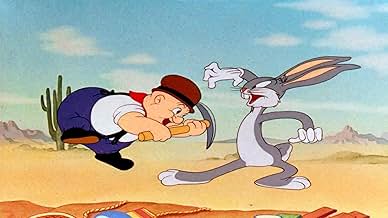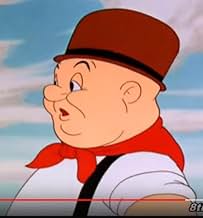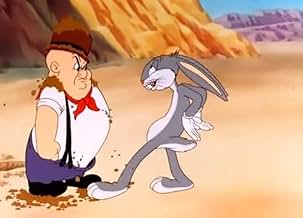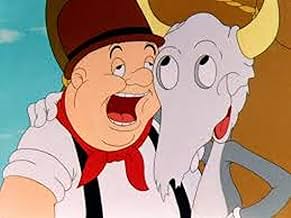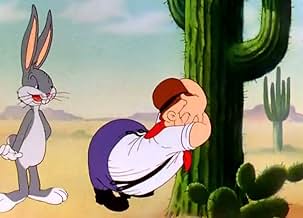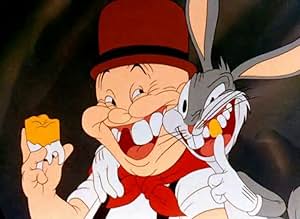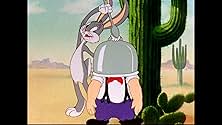IMDb RATING
7.3/10
1.2K
YOUR RATING
Bugs arrives in the desert to find Elmer prospecting for gold. Fudd is finally driven to pull his own gold tooth.Bugs arrives in the desert to find Elmer prospecting for gold. Fudd is finally driven to pull his own gold tooth.Bugs arrives in the desert to find Elmer prospecting for gold. Fudd is finally driven to pull his own gold tooth.
- Director
- Writer
- Stars
Mel Blanc
- Bugs Bunny
- (voice)
- (uncredited)
- …
Arthur Q. Bryan
- Elmer Fudd
- (voice)
- (uncredited)
- Director
- Writer
- All cast & crew
- Production, box office & more at IMDbPro
Featured reviews
Starting with a cactus encouraging us to buy war bonds, we follow "Elmer" twamping and twudging through the desert ready for his own personal gold rush. Meantime, "Bugs" is carefully camouflaged inside a sheep's skull and after a rousing duet of "Oh Susannah" watches his patsy set about beginning his mining operation. Well, it's really just him, a pick axe and some dynamite! Might "Elmer" have been based on Walter Brennan, I wonder? Anyway, what ensues here is a bit repetitive and after a few minutes I was a little too settled into the obvious dynamic. It's not that cartoons didn't usually follow a formula, it's maybe just that the two characters here don't really engage for me. I always found "Bugs" a bit smug! It's watchable, though - just not very memorable and there's far too much dialogue, too.
Bugs Bunny and Elmer Fudd have always been great characters, two of the best in the Looney Tunes canon, and they've always been enormously entertaining as a duo. The Wacky Wabbit is one of their earliest collaborations, and for me it's also one of their best and one of the best of Bob Clampett's Bugs Bunny cartoons.
The animation is very good, especially for such an early Looney Tunes cartoon. It is true that Elmer and Bugs' character designs are very different to the ones we know them now by and admittedly first time seeing them in their early designs it took me a while to get used to Elmer's fatter and stockier (apparently more reminiscent of his voice actor) and Bugs' longer- particularly the ears- and more pointed looks, but they are still well drawn and move well within the rest of the animation and it is actually really interesting to see how these two characters evolved over the years. The colours are luscious and richly bold, if more vibrant-looking a short time later, and there is a huge amount of meticulous detail, fluidity and imagination in the backgrounds.
Carl Stalling's music score, as expected, is superb. It is very characterful and often enhances the cartoon's energy (and The Wacky Wabbit is full of it, in the music, pacing and the gags), the orchestration is mellow and beautiful with very clever use of instruments, that perfectly match the gestures and expressions of the characters and the suspense and energy of the cartoon itself, and rhythmically it's non-stop liveliness and atmosphere. Love the use of Bury Me Not on the Prairie and especially the inspired Oh Susannah, the visuals are great in both especially the latter, the harmonies in Oh Susannah are lovely and the lyrics are very humorous. The dialogue is sharp and hilariously zany, the verbal interplay is such a joy, while the gags do show evidence of the wonderfully wacky style the Looney Tunes cartoons had (it's true that the style didn't hit full stride until mid-40s, but there is evidence of it in The Wacky Wabbit), the cutting of Elmer's clothes gag revealing a corset and his reaction is a particularly strong gag. The dynamite gags are great too.
Bugs is every bit as wacky as the title suggests and even when meaner to Elmer than their later collaborations he is still the hilarious Bugs Bunny we know and love. Elmer may be unrecognisable from his more famous and to be honest more appealing appearance later on, but he is appropriately dim-witted and is equally as funny and as much a threat to Bugs (and vice versa), and one does feel a bit of sympathy for him. Their interplay and chemistry is as ever so much fun to watch. Mel Blanc and Arthur Q. Bryan do a characteristically terrific job with the voices.
All in all, a wonderful cartoon, one of the duo's best and one of Clampett's best. 10/10 Bethany Cox
The animation is very good, especially for such an early Looney Tunes cartoon. It is true that Elmer and Bugs' character designs are very different to the ones we know them now by and admittedly first time seeing them in their early designs it took me a while to get used to Elmer's fatter and stockier (apparently more reminiscent of his voice actor) and Bugs' longer- particularly the ears- and more pointed looks, but they are still well drawn and move well within the rest of the animation and it is actually really interesting to see how these two characters evolved over the years. The colours are luscious and richly bold, if more vibrant-looking a short time later, and there is a huge amount of meticulous detail, fluidity and imagination in the backgrounds.
Carl Stalling's music score, as expected, is superb. It is very characterful and often enhances the cartoon's energy (and The Wacky Wabbit is full of it, in the music, pacing and the gags), the orchestration is mellow and beautiful with very clever use of instruments, that perfectly match the gestures and expressions of the characters and the suspense and energy of the cartoon itself, and rhythmically it's non-stop liveliness and atmosphere. Love the use of Bury Me Not on the Prairie and especially the inspired Oh Susannah, the visuals are great in both especially the latter, the harmonies in Oh Susannah are lovely and the lyrics are very humorous. The dialogue is sharp and hilariously zany, the verbal interplay is such a joy, while the gags do show evidence of the wonderfully wacky style the Looney Tunes cartoons had (it's true that the style didn't hit full stride until mid-40s, but there is evidence of it in The Wacky Wabbit), the cutting of Elmer's clothes gag revealing a corset and his reaction is a particularly strong gag. The dynamite gags are great too.
Bugs is every bit as wacky as the title suggests and even when meaner to Elmer than their later collaborations he is still the hilarious Bugs Bunny we know and love. Elmer may be unrecognisable from his more famous and to be honest more appealing appearance later on, but he is appropriately dim-witted and is equally as funny and as much a threat to Bugs (and vice versa), and one does feel a bit of sympathy for him. Their interplay and chemistry is as ever so much fun to watch. Mel Blanc and Arthur Q. Bryan do a characteristically terrific job with the voices.
All in all, a wonderful cartoon, one of the duo's best and one of Clampett's best. 10/10 Bethany Cox
In this very good short Elmer Fudd is a gold prospector in a desert.He is constantly singing"Oh Susana".He has to face the hard conditions of the desert and also a certain Bugs Bunny out to demolish his every hope.One of my favorite shorts.Bugs and Elmer are real threats to each other.Bugs here is quite sinister too.Elmer doesn't even provoke him.The hopeless Elmer seems quite mad in the end when he laughs having taken his own gold tooth out.Serves to point how demented Warner Bros toons can be.Much better than today's sugary toons.
The major Warner Brothers characters, at least the early ones, evolved over time into the characters best known today. Bugs, Daffy, Porky and Tweety all started out looking quite different in the beginning. But perhaps the most involved and extensive changes were made by Elmer Fudd. He started out as Egghead, got a name change to Elmer and then a physical change of appearance not once, but twice! This is the early, more rounded Elmer. Probably one of the best of the early Elmers and an excellent short. Well worth watching. Recommended.
After Elmer Fudd debuted in the late 1930s, the folks at Looney Tunes decided to make the character look more like the voice actor who voiced him, Arthur Q. Bryan. As a result, the character is much more obese and unattractive. After a few films like this, the studio decided the retooled Elmer was a bad idea and returned to the more familiar version we are used to today.
This cartoon finds Elmer in the desert prospecting for gold. Not surprisingly, Bugs arrives mostly just to annoy him...and delight the audience.
There are several refences to the war (such as war bond posters and the lyrics to the song Elmer sings) but otherwise this is a timeless sort of film...enjoyable and full of the antics we all love.
This cartoon finds Elmer in the desert prospecting for gold. Not surprisingly, Bugs arrives mostly just to annoy him...and delight the audience.
There are several refences to the war (such as war bond posters and the lyrics to the song Elmer sings) but otherwise this is a timeless sort of film...enjoyable and full of the antics we all love.
Did you know
- TriviaLots of wartime references here, which audiences of the time would have appreciated. Early on there's a glimpse of an ad extolling people to buy war bonds. And the phrase V for Victory is sung several times.
- GoofsThe tooth Elmer is holding is a molar, but the missing tooth is an incisor.
- Quotes
Elmer Fudd: [wearing a girdle] Don't waugh. I'll bet pwenty of you men wear one of these.
- ConnectionsFeatured in Så er der tegnefilm: Episode #14.9 (1989)
- SoundtracksOh, Susanna
(uncredited)
Written by Stephen Foster
[Sung with substitute lyrics by Elmer Fudd and Bugs Bunny.]
Details
- Release date
- Country of origin
- Language
- Also known as
- Merrie Melodies #17 (1941-1942 Season): The Wacky Wabbit
- Production company
- See more company credits at IMDbPro
- Runtime
- 7m
- Sound mix
- Aspect ratio
- 1.37 : 1
Contribute to this page
Suggest an edit or add missing content

